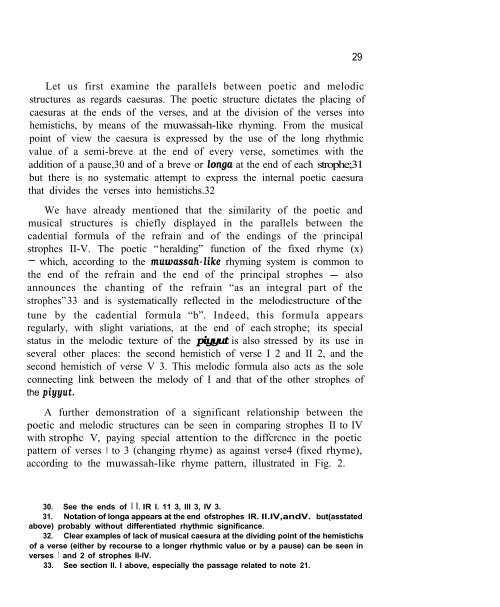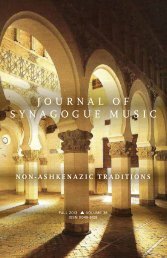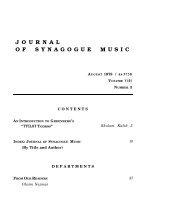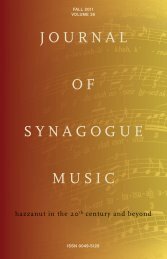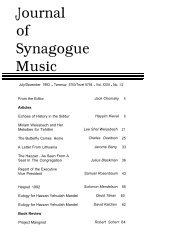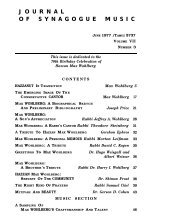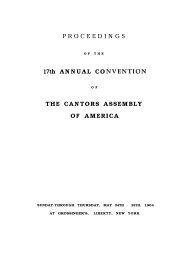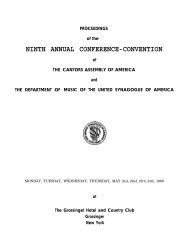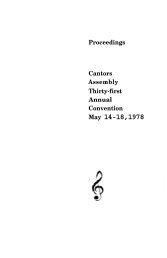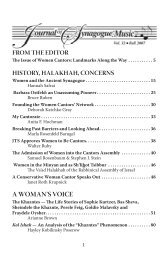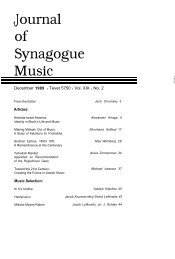Volume 16, Number 2 - Cantors Assembly
Volume 16, Number 2 - Cantors Assembly
Volume 16, Number 2 - Cantors Assembly
You also want an ePaper? Increase the reach of your titles
YUMPU automatically turns print PDFs into web optimized ePapers that Google loves.
Let us first examine the parallels between poetic and melodic<br />
structures as regards caesuras. The poetic structure dictates the placing of<br />
caesuras at the ends of the verses, and at the division of the verses into<br />
hemistichs, by means of the muwassah-like rhyming. From the musical<br />
point of view the caesura is expressed by the use of the long rhythmic<br />
value of a semi-breve at the end of every verse, sometimes with the<br />
addition of a pause,30 and of a breve or longa at the end of each strophe;31<br />
but there is no systematic attempt to express the internal poetic caesura<br />
that divides the verses into hemistichs.32<br />
We have already mentioned that the similarity of the poetic and<br />
musical structures is chiefly displayed in the parallels between the<br />
cadential formula of the refrain and of the endings of the principal<br />
strophes II-V. The poetic “heralding” function of the fixed rhyme (x)<br />
- which, according to the muwassah-like rhyming system is common to<br />
the end of the refrain and the end of the principal strophes - also<br />
announces the chanting of the refrain “as an integral part of the<br />
strophes”33 and is systematically reflected in the melodicstructure of the<br />
tune by the cadential formula “b”. Indeed, this formula appears<br />
regularly, with slight variations, at the end of each strophe; its special<br />
status in the melodic texture of the piyyut is also stressed by its use in<br />
several other places: the second hemistich of verse I 2 and II 2, and the<br />
second hemistich of verse V 3. This melodic formula also acts as the sole<br />
connecting link between the melody of I and that of the other strophes of<br />
the piyyut.<br />
A further demonstration of a significant relationship between the<br />
poetic and melodic structures can be seen in comparing strophes II to IV<br />
with strophc V, paying special attention to the diffcrcncc in the poetic<br />
pattern of verses I to 3 (changing rhyme) as against verse4 (fixed rhyme),<br />
according to the muwassah-like rhyme pattern, illustrated in Fig. 2.<br />
30. See the ends of I I. IR I. 11 3, III 3, IV 3.<br />
31. Notation of longa appears at the end ofstrophes IR. II.IV,andV. but(asstated<br />
above) probably without differentiated rhythmic significance.<br />
32. Clear examples of lack of musical caesura at the dividing point of the hemistichs<br />
of a verse (either by recourse to a longer rhythmic value or by a pause) can be seen in<br />
verses 1 and 2 of strophes II-IV.<br />
33. See section II. I above, especially the passage related to note 21.<br />
29


